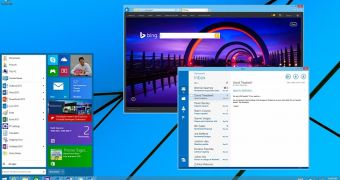Microsoft confirmed at the BUILD 2014 developer conference that the Start menu would return at some point in Windows, explaining that the company wants to give desktop users more control over their new computer running a modern version of Windows.
Terry Myerson, Microsoft's executive vice president of Operating Systems, also offered a preview of the way the new Start menu could look like, but he hasn’t actually provided any details regarding the launch date of this new exciting feature.
He did however mention that the Start menu is set to arrive “in the next iteration of Windows,” which most likely means that users would only see this traditional Windows feature back when Windows 9 hits the market.
While no details have been provided on Windows 9, previous reports indicated that Windows 9 could be launched in spring 2015, approximately one year after the debut of Windows 8.1 Update.
“I previewed some work we are doing for the next iteration of Windows, which builds on the journey we began with Windows 8 just over a year ago as well as the releases we’ve done since then. In particular, I showed some early thinking on how the user experience in Windows will evolve in a way that will help developers’ apps make their way to users across devices and form factors,” Myerson said.
“We set out to do this is a thoughtful way – one where we could enable more productivity for customers working in desktop mode, while building smart bridges to the new modern user experience and ensuring customers can get access to all your great apps in the Windows Store no matter where they are in the experience, or which device type they’re on.”
As you can see in this photo, the Start menu combines the traditional design available in Windows 7 with the modern touch of the Start screen, thus offering users not only quick access to the installed apps, but also live tiles to receive updates on the go.
Power controls are also being offered to quickly shut down or reboot your computer and so is a search function that allows you to look for information locally and online.
The same screenshot also shows that Microsoft is working to make Metro apps run in their own windows, thus mixing the Modern UI with the desktop and thus giving the touch-optimized environment a new chance to succeed on the traditional PC.

 14 DAY TRIAL //
14 DAY TRIAL //